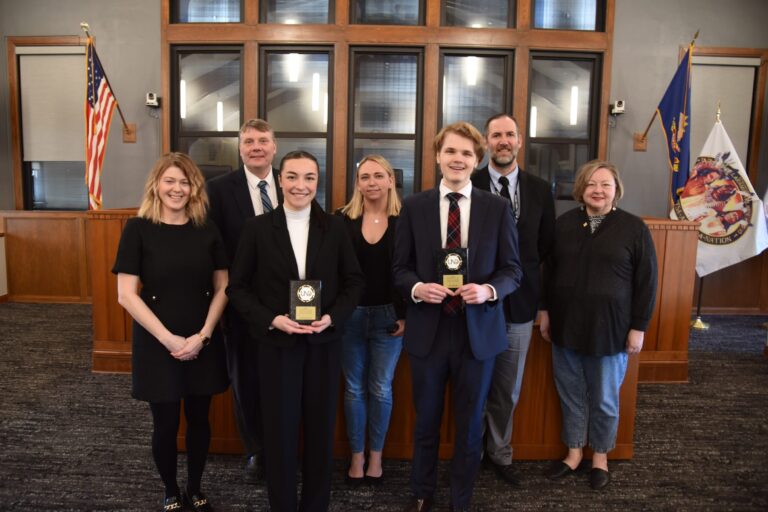Longtime Detroit Lakes attorney, David Stowman ’72, recalls military service during turbulent times in Vietnam
Stowman earned the Bronze Star and several other medals, commendations, ribbons and citations during the 13 months he fought as a Marine in Vietnam. But he doesn’t consider himself a hero, and he doesn’t like to see war glorified. He says, “If there is any glory in war, it rests with those who did not return.”
DETROIT LAKES — Marine Captain David Stowman earned the Bronze Star, the Cross of Gallantry with the Bronze Star, and seven other medals, commendations, ribbons and citations during the 13 months he fought in Vietnam.
But Stowman doesn’t consider himself a hero, and doesn’t like to see war glorified.
“It bothers me when people talk about war like it’s moving pawns on a chessboard,” he said. “War is real people living the event. It’s people losing limbs, losing their health, and in some instances, losing their sanity. It is family separation and families losing loved ones. War is about killing other humans. For the participants, war does not end with the end of the war. It’s a lifetime event. If there is any glory in war, it rests with those who did not return.”
Stowman, a longtime attorney in Detroit Lakes, served in the Vietnam War in 1967 and ’68, during one of its most turbulent periods — which included the battle of Khe Sanh and the Tet Offensive.
Stowman arrived in Vietnam around Thanksgiving of 1967, and came home just before Christmas of ’68.
During his time in Vietnam, he was promoted from lieutenant to captain, and went from platoon leader in charge of about 25 men to company commander in charge of about 125 men, though he said his responsibilities didn’t change all that much.
Of course, that was some 55 years ago, and the things that most stick in his mind aren’t so much the fighting and tactics used during his time in the First Marine Division, I-Corps, but the loss of life and the surreal moments that happened in wartime.
Such as a plane ride to an airstrip near the demilitarized zone between North and South Vietnam.
“You get in those cargo planes, and there’s no seats. You sit on the floor and grab a strap that runs across the floor,” he said. “I’m sitting next to this dog, a German shepherd — he’s muzzled, but he’s not happy. He doesn’t want to be there. He’s growling and snapping.”
To make matters worse, the enemy was shelling the airfield as the plane tried to land, forcing the pilot to drop sharply on his approach rather than glide smoothly in, to avoid enemy fire. When the plane dropped like that, the airflow seemed to stop, and it got really hot inside the plane.
“People were airsick, vomiting, and the dog was snapping, and you could hear the concussions (of the shelling) when we got close, so they’d climb back up and repeat and repeat,” Stowman said. “Finally, in-between shelling, we got in. But it’s funny how your mind works — I was more concerned about that dog next to me than getting shot out of the sky.”
He fought against both North Vietnamese regulars infiltrating from the north and Viet Cong guerrilla fighters hidden among the locals in South Vietnam. The guerrillas often sent “sappers” to sneak into American encampments, hoping to set off explosives and escape in the confusion.
“One night some sappers got through the perimeter,” Stowman said. “They carried canvas satchels loaded with explosives, and they did their damage, but they didn’t get out alive. Their bodies were draped over the perimeter fence like deer during hunting season.”
As the sun rose, villagers came to claim the bodies.
“I can’t remember having any sympathy for the sappers, and I didn’t have a lot of warm fuzzies for the family members, either,” he said. But he has never forgotten the haunting wails of grief from the mothers of the dead: “Enemy combatants have mothers, too.”
The Tet Offensive
Stowman was in Vietnam during the Tet Offensive, one of the biggest offensive actions in the war to that point.
The Tet holiday in Vietnam celebrates the lunar new year, and “it’s like Christmas and Thanksgiving and New Year’s Eve all rolled into one,” Stowman said. “It’s a big holiday for the Vietnamese.”
North Vietnam and the Viet Cong took advantage of all the holiday travel, and vacation time for South Vietnamese troops, to infiltrate about 85,000 troops into about 100 cities and towns, Stowman said.
“The lights on a Christmas tree all turn on simultaneously when you plug it in,” he said. The Tet attack was like that: “They were attacking all the population centers at one time.”
That means there wasn’t a front line, there was fierce fighting all over the country.
Stowman was involved in the fighting in Hue, which was largely overrun in the early morning hours of Jan. 31, 1968.
Hue was the site of the old capital city of Vietnam, which featured a 6-foot-thick walled citadel and 6-mile-long ringing moat. The imperial residence was inside the citadel, near the Perfume River. A second set of tall walls and a second moat were built around this Imperial City, with gated courtyards, gardens, pavilions and palaces.
“It was like things out of a fairytale — the bridge and moat and temples,” Stowman said. “I remember the Citadel was huge — rich red colors with gold leaf. It was shot up. There was a lot of damage.”
At the Citadel, the situation was chaotic, with Viet Cong troops holding some parts and South Vietnamese troops occupying others, while warplanes targeted anti-aircraft guns the communists had placed on the Citadel’s outer towers.
At first, U.S. troops were ordered not to bomb or shell the city, for religious and cultural reasons and to protect the historic buildings. But that changed during bloody house-to-house fighting, and the Tet offensive resulted in serious damage to the city.
The communists held Hue for 28 days.
“They were pretty violent,” Stowman said. “Mass graves were found after Tet with 3,000 people in them. The North Vietnamese shot them, clubbed them to death, some were buried alive.”
The main Tet Offensive ended in February of 1968.
“It was the most violent time for Americans in Vietnam,” Stowman said, “but the North Vietnamese took huge casualties. We won the tactical war, but they won the propaganda war in the United States. After that, support for the war really started to wane.”
Prior to Tet, the political line in America was, “we’re winning the war, we’re winning the war,” Stowman said. “After Tet, the perception was, we were really vulnerable.”
Battle of Khe Sanh
While the Tet Offensive was going on, North Vietnam attacked over the demilitarized zone on Jan. 21, 1968, launching a massive artillery bombardment on an isolated Marine garrison at Khe Sanh, in a sparsely populated area near the Laos border.
North Vietnam hoped to repeat the 1954 victory at Dien Bien Phu, where French forces were overrun and destroyed, causing the French colonizers to leave Vietnam.
About 5,500 Marines and South Vietnamese troops at Khe Sanh spent the next 77 days fighting off an intense siege by about 20,000 North Vietnamese troops. It was one of the longest and bloodiest battles of the war, and Stowman’s troops were among those sent to break through to the encircled base.
“I had a lot of friends there,” he said.
Again, the end result of the battle was a victory for the Americans, after about 100,000 tons of explosives were dropped on the encircling North Vietnamese, who suffered high casualties. But a few months later, the strategy changed, the base was abandoned, and the North Vietnamese took possession and claimed victory.
While Vietnam was so narrow at the demilitarized zone that “you could almost spit across it,” Stowman said, the whole U.S. strategy of building a “fence” of bases near that zone didn’t work. The communists bypassed the bases by using the Ho Chi Minh Trail to move troops and supplies through neutral Laos and Cambodia.
Surviving an ambush
In Vietnam, Stowman used a map and compass to call in mortar and artillery strikes during combat. The first “sighting” strikes were never on target — he had to “walk” the strikes over to the correct position and then order “fire for effect,” which unleashed the full shelling on whomever was there.
So he knew it when the same thing was happening to him.
At one point, he said, “we were ambushed by mortars.”
He and his men were pinned down, and he could see the sighting strikes coming closer and closer to their position.
“They walked them right up to us, and I knew the next order would be ‘fire for effect.’ But nothing happened. The order never came,” he said, expressing how that was an incredible relief.
“Nothing in the world is so exhilarating as to be shot at without effect,” he said with a smile.
Stowman grew up in Rothsay and then went on to earn a double-major in biology and psychology at what was then Moorhead State University. He graduated and joined the Marine Corps at the same time, in a special ceremony.
In Vietnam, he served honorably and courageously, and coming home from the war was good. But the civilian reception near Camp Pendleton in California was bad, he said. The war was unpopular, so the soldiers that fought in it were unpopular, too.
“Veterans were called baby killers, warmongers, psychos,” he said.
That’s why even now he always greets returning veterans with a big “Welcome home!” he said.
He went to law school, choosing the University of North Dakota in part because “it was close to home,” he said. “At this point in my life, the big concern was being close to home.”
When he launched his law career, he and his wife, Judy, knew they wanted to live on a lake, and ended up in Detroit Lakes, even though they had never been to the area before. They raised four children in Detroit Lakes — Jeff, who helps run the law firm; Mike, an emergency room doctor; Matt, an engineer; and Anne, a pathologist.

